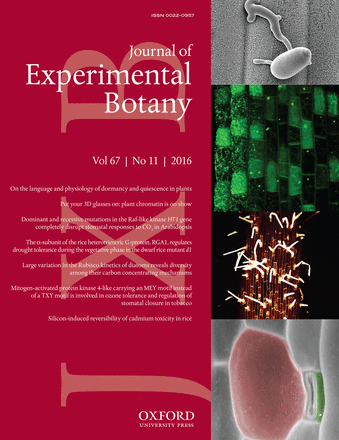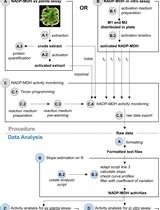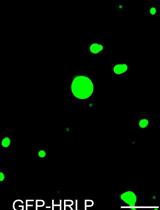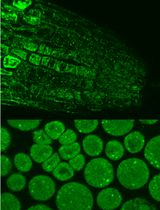- EN - English
- CN - 中文
In vitro Ubiquitin Dimer Formation Assay
体外泛素二聚体形成检测实验
发布: 2017年01月05日第7卷第1期 DOI: 10.21769/BioProtoc.2082 浏览次数: 8589
评审: Yanjie LiQiangjun ZhouAnonymous reviewer(s)
Abstract
The process of protein ubiquitination typically consists of three sequential steps to add an ubiquitin (Ub) or Ub chain to a substrate protein, requiring three different enzymes, ubiquitin activating enzyme (E1), ubiquitin conjugating enzyme (E2), and ubiquitin protein ligase (E3). Most E2s possess the classical E2 activity in forming E2-Ub complex through a thioester linkage, in presence of an E1 and Ub. Additionally, some E2s have the ability of catalyzing the formation of free Ub dimer. Such activity indicates an important role of these E2s in ubiquitination pathway. Thus, we developed an in vitro Ub dimer formation assay to determine the activity of certain E2s. Moreover, by using Ub mutants, in which different lysine residues are mutated, the specific linkage of dimer can also be determined.
Keywords: Ubiquitination (泛素化)Background
The existing protocols for E2 conjugation initiation assay (without adding E3 and substrate) aim to detect the thioester linkage (E2-S-Ub). Our method focuses on the E2 activity of catalyzing free Ub dimer formation (Ub-Ub). It provides a convenient way to detect an important biochemical feature of E2 in different species. Further, the specific linkage of dimer can be determined by using different Ub mutants.
Materials and Reagents
- 1.5 ml polypropylene tubes
- Polyvinylidene difluoride (PVDF) membrane (Bio-Rad Laboratories, catalog number: 162-0177 )
- AmershamHyperfilmTM ECL (GE Healthcare, catalog number: 28906836 )
- Purified human recombinant E1 (BOSTONBIOCHEM, catalog number: K-995 )
- Qiagen Ni-NTA Spin Kit (QIAGEN, catalog number: 31314 )
- Purified human recombinant Ub (BOSTONBIOCHEM, catalog number: K-995 )
- Purified human recombinant Ub with the lysine 11 (K11) residue mutated (Ub-K11R) (BOSTONBIOCHEM, catalog number: UM-K11R )
- Purified human recombinant Ub with the lysine 48 (K48) residue mutated (Ub-K48R) (BOSTONBIOCHEM, catalog number: UM-K48R )
- Purified human recombinant Ub with the lysine 63 (K63) residue mutated (Ub-K63R) (BOSTONBIOCHEM, catalog number: UM-K63R )
- 10x reaction buffer (BOSTONBIOCHEM, catalog number: K-995 )
- Mg-ATP solution (BOSTONBIOCHEM, catalog number: K-995 )
- 4x non-reducing loading buffer (BOSTONBIOCHEM, catalog number: K-995 )
- SDS-PAGE gel
- Skimmed milk powder
- Anti-ubiquitin antibody (Cell Signaling Technology, catalog number: 3936 )
- Goat anti-mouse antibody conjugated to horseradish peroxidase (HRP) (Bio-Rad Laboratories, catalog number: 170-6516 )
- Amersham ECL prime Western blotting detection reagent (GE Healthcare, catalog number: RPN2232 )
- NaCl
- KCl
- Na2HPO4
- KH2PO4
- Tween-20 (Sigma-Aldrich, catalog number: P1379 )
- Tris base
- Glycine
- Methanol
- Dialysis buffer (see Recipes)
- 1x PBS (see Recipes)
- 1x PBST (see Recipes)
- Transfer buffer (see Recipes)
Equipment
- Incubator (VWR, model number: 1545 ) or water bath
- Protein electrophoresis apparatus (Bio-Rad Laboratories, model: Mini PROTEAN® 3 Cell )
- Western blotting apparatus (Bio-Rad Laboratories, model: Mini Trans-Blot® Cell )
- X-Ray film processor (PROTEC, model: OPTIMAX )
Procedure
文章信息
版权信息
© 2017 The Authors; exclusive licensee Bio-protocol LLC.
如何引用
Wang, S., Cao, L. and Wang, H. (2017). In vitro Ubiquitin Dimer Formation Assay. Bio-protocol 7(1): e2082. DOI: 10.21769/BioProtoc.2082.
分类
植物科学 > 植物生物化学 > 蛋白质 > 修饰
植物科学 > 植物生物化学 > 蛋白质 > 活性
生物化学 > 蛋白质 > 修饰
您对这篇实验方法有问题吗?
在此处发布您的问题,我们将邀请本文作者来回答。同时,我们会将您的问题发布到Bio-protocol Exchange,以便寻求社区成员的帮助。
Share
Bluesky
X
Copy link













